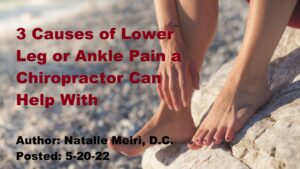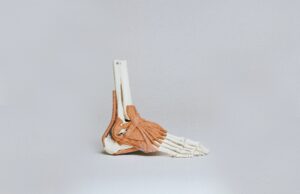
This post is about 3 Causes of Lower Leg or Ankle Pain a Chiropractor Can Help With. Exercise induced lower leg or ankle pain is common among athletes. Overuse injuries from hobbies or work can also cause varying degrees of muscle, tendon and bone irritation. Your leg pain may also be coming from your back or be a systematic (affecting entire body) problem.
Achilles Tendinitis
Achilles Tendinitis occurs in athletes following jumping or running activities. You will have pain in the achilles tendon because it is inflamed. So a tendon is a dense fibrous connective tissue that attaches a muscle to other body parts, usually bones. It transmits the mechanical force of muscle contraction to the bones. The achilles tendon is a very large tendon which connects the gastronemius and soleus (calf muscles) to your calcaneus (heel bone). It is used when you walk, run, and jump.
Cause
Firstly, the Achilles tendon is covered by a peritenon (connective tissue sheath surrounding a tendon) composed of mainly areolar tissue (fatty tissue) which functions as a cushion. The area most affected in tendinitis is approximately 2 cm proximal (close) to the calcaneal insertion (heel attachment). The demands on the tendon are high in running and jumping sports.
Secondly, at the heel insertion (attachment site) there can be a complicating problem. The retrocalcaneal bursa (small cushioning sac between the heel bone and the achilles tendon) can get irritated. Eventually, this may lead to a Haglund’s deformity (bony enlargement found on the back of the heel).
Thirdly, if you have arthritis due to reiter’s syndrome or ankylosing spondylitis which are systemic diseases (affecting entire body), it can cause what’s called an enthesopathy. Enthesopathy is a disorder of the entheses. The “enthesis” is the area where the tendon, ligament, or joint capsule inserts into bone.
Finally, in athletic children, pain and tenderness at the calcaneus (heel bone) may indicate sever’s disease/apophysitis. Sever’s disease is a painful condition of the heel that occurs in growing children. It happens when the tendon that attaches to the back of the heel (the Achilles tendon) pulls on the growth plate (the apophysis) of the bone of the heel (the calcaneus).

Shin Splints
Shin splints cause anterior (front of) or posterior (back of) lower leg pain that is often insidious (comes on gradually) in onset. Walking or running on a hard surface is a common inciting activity. Shin splints pain is a deep ache that is often worse with weight bearing.
Cause
Shin splints have many possible causes. Lower leg tendinitis, periostitis (inflammation of the periosteum, a layer of connective tissue that surrounds bone), muscle strain, or interosseous membrane (thick dense fibrous sheet of connective tissue) strain are all possible causes.
There are generally two types: anterior (front of leg) shin splints and posterior (back of leg) shin splints.
The anterior (front of leg) shin splints involves 3 muscles all located in the front of the tibia (shin bone): tibialis anterior (moves foot upwards), extensor hallucis longus (moves the big toe upward), and extensor digitorum longus (moves 2nd to fifth toes upward). So these muscles are used for “shock absorption”. Shock absorption is the process by which an object — in this case, your muscles — absorbs the brunt of the impact forces you sustain during movement. What occurs in shin splints is these muscles may be weak or placed under increased demand as in walking or running on hard surfaces. Furthermore, when your shoe has no shock-absorbing quality, the force is transmitted to the tibia (shin bone) and its attachments.
The posterior (back of lower leg) type of shin splints involves 3 muscles all located in the back of the tibia (shin bone): the tibialis posterior (points the foot), flexor hallucis longus (points the big toe), and flexor digitorum longus (points the 2nd to fifth toe) muscles. The soleus (calf muscle) could also cause shin splints . These muscles act as ankle stabilizers. And they are overstrained if your foot is hyperpronated (inward rotation of the foot during gait).
Throwing away worn-out shoes and replacing them with a good shock-absorbing pair is important if you have shin splints.
Ankle Sprains
Ankle sprains can occur at any age. You will have ankle pain and swelling following a twisting injury. You may simply step on an uneven surface or land on the outside heel and get an ankle sprain. However, you may not recall how it happened.
Cause
The vast majority of ankle sprains are plantarflexion (movement in which the ankle and foot bends forward or downward) and inversion (bending the ankle and foot inward toward the mid-line of the body) injuries. Furthermore, these sprains involve the lateral (side) ligaments (fibrous connective tissue that connects bones to other bones). In a sequence of injury: the anterior talofibular (ankle bone and long, thin and side bone of the lower leg) ligament, calcaneofibular (heel bone and long, thin and side bone of the lower leg) ligament, and the posterior talofibular (rear ankle bone and long, thin and side bone of the lower leg) ligament which are the lateral (outer side) ligaments. The more rare eversion turning (movement where ankle/foot bends inside-out) sprain damages the medial (toward middle) ligament complex referred to as the deltoid ligament.
Running on uneven surfaces or landing on the outside heel can cause ankle sprains. If you have a cross-over gait (involves running with your feet crossing the midline of your body) or over supinate (put most of the weight on the outer side of your feet) this may lead to ankle sprain injuries. Consequently, if you keep getting subsequent sprains, you may get ligament laxity (looseness of a limb or muscle). This will play an important role in future ankle injuries.
Treatment for 3 Causes of Lower Leg or Ankle Pain a Chiropractor Can Help With at Meiri Chiropractic:
In the acute phase, ice and rest from the causative activity are essential. Myofascial release techniques are effective. Therapeutic exercises are prescribed for stretching, strengthening, and stabilization. Most importantly, Chiropractic adjustments, manipulation, and mobilization to the leg, ankle, foot and associated areas give relief.
Prevention is important with managing lower leg and ankle pain. Lower leg and ankle pain account for a lot of time lost in athletics. And football teams spend as much as $50,000 annually on tape for ankles!
A comparative study evaluated the outcome of treating Grade I and II ankle sprains with a chiropractic ankle adjustment or detuned ultrasound (placebo). There was significantly more improvement in the adjusted group for pain, range of motion, and function.
Getting regular chiropractic care from a West Palm Beach lower leg or ankle pain chiropractor can help relieve pain naturally from an already existing injury, or even offer injury prevention. Chiropractic is a holistic and natural way to not only treat existing injuries, but to keep your body in its best working condition.
Contact Meiri Chiropractic today on the 3 Causes of Lower Leg or Ankle Pain a Chiropractor Can Help With or/and other ailments.
References:
Thomas Bergman, David Peterson, Chiropractic Technique Principles and Procedures, 3rd edition, 2011
Meiri Chiropractic
561-253-8984
